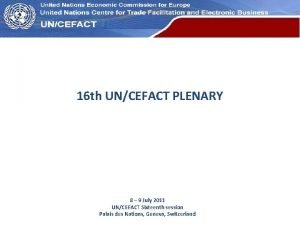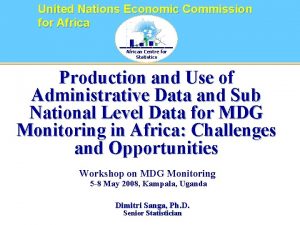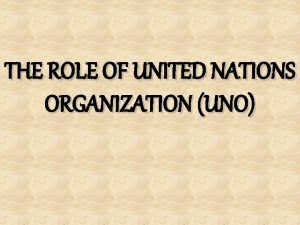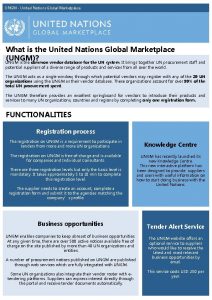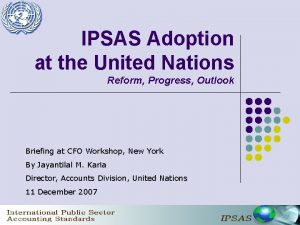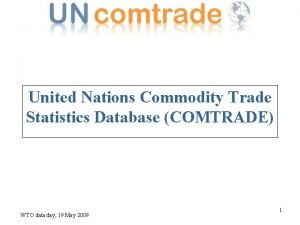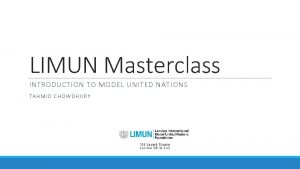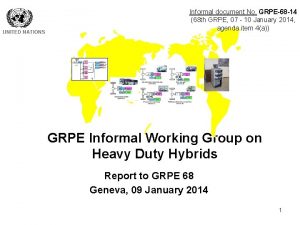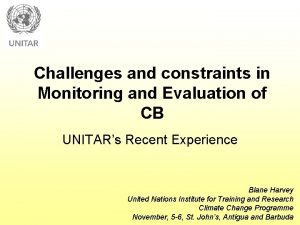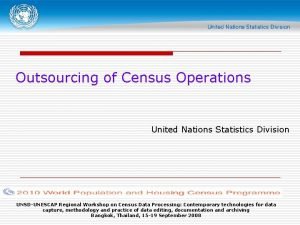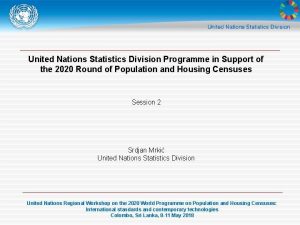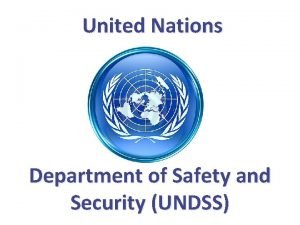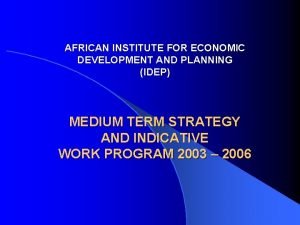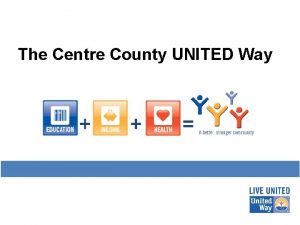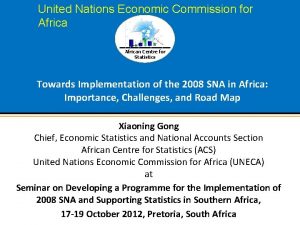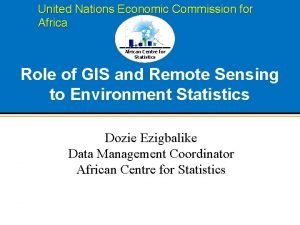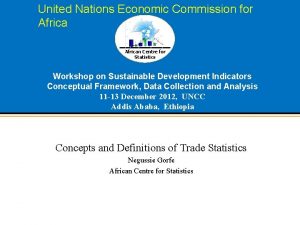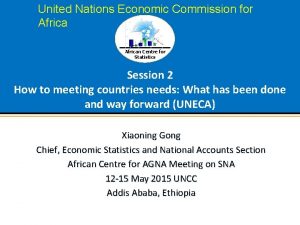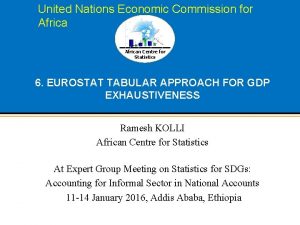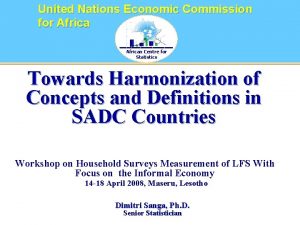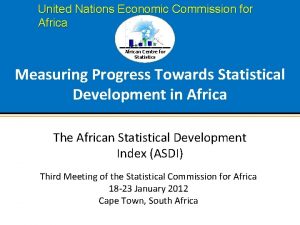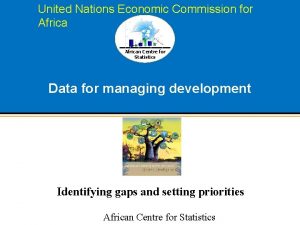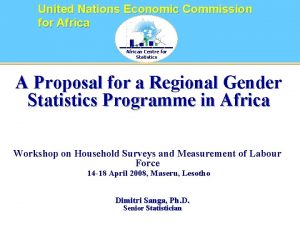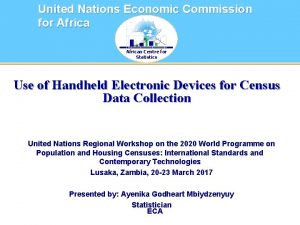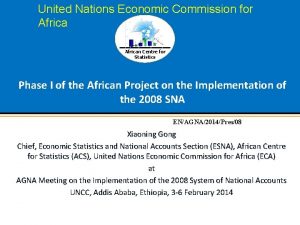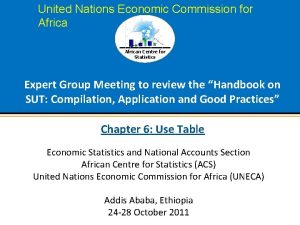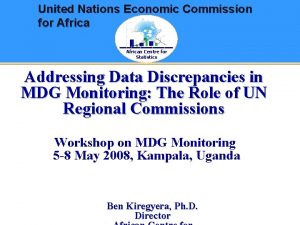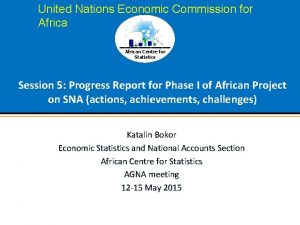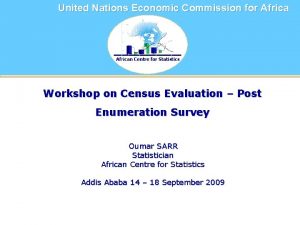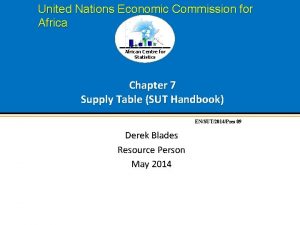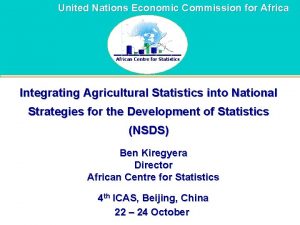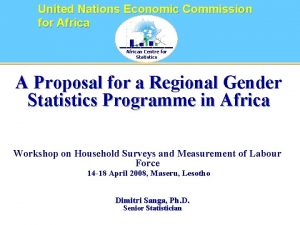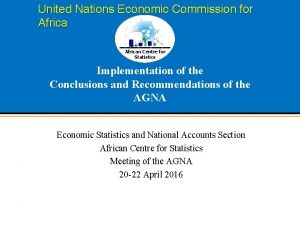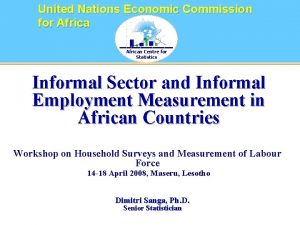United Nations Economic Commission for African Centre for







































- Slides: 39

United Nations Economic Commission for African Centre for Statistics Production and Use of Administrative Data and Sub National Level Data for MDG Monitoring in Africa: Challenges and Opportunities Workshop on MDG Monitoring 5 -8 May 2008, Kampala, Uganda Dimitri Sanga, Ph. D. Senior Statistician

Outline l Background l Data Sources for MDG Monitoring l Use of Administrative Data Sources for MDG Monitoring l The Need for MDG Data at the Sub National Level l The Way Forward 2

Background 3

MDG Monitoring l Monitoring and evaluation of progress made towards the achievement of the MDGs is data intensive l They require data from various sources produced using different tools l The choice of the source depends on the availability of the data and the indicator 4

Data sources for MDG monitoring l The main sources of data for MDG monitoring include: ØHousehold surveys ØCensuses ØAdministrative records: Health, education statistics ØCivil and vital registration systems: birth, deaths, marriages, divorces… 5

Data sources for MDG monitoring (2) l Different indicators require different type of data l Sometimes, multiple types of data could shed light on a single MDG indicator l Thus, the need for making a choice of data source 6

Example 1: Mortality l Data on mortality (infant, child and maternal) can be obtained from: ØVital registration systems ØHousehold sample surveys l In most developing countries: ØRegistration of births and deaths is incomplete ØUnderestimation of mortality rates ØHousehold sample surveys are the commonly-used data source to estimate mortality ØSince mortality is a relatively rare event: need for large surveys to capture enough deaths to obtain reliable estimates of mortality 7

Example 2: Education l Many countries use administrative data (data from school registers) to calculate primary or secondary enrollment rates l Enrollment rates based on administrative data overstate those based on HS: ØAdministrative data report on the number of children enrolled at the beginning of the school year ØHS data typically report school attendance data (Does your child currently attend school? ) 8

Advantages of administrative data sources l Reduction of response burden as the NSO would have access to the data provided by the system l Provide data on small areas and targeted population groups l Coverage at relatively low cost as compared to other sources l Possibility to link with other data sources and to produce new type of data and statistics 9

Use of Administrative Data Sources for MDG Monitoring 10

Administrative data Data produced in countries on the basis of some administrative processes l Compiled in the course of routine operations of government ministries and institutions l Units and variables defined according to : l ØAdministrative acts ØRules ØRegulations l Definitions adopted in the administrative data may differ from the needs of the official statistics 11

Vital and civil registration systems l Vital and civil registration systems (VCRS): ØRecord the occurrence and characteristics of vital events: birth, death and causes of death, marriage, etc. ØBased on laws, regulations and other legal requirements l If complete, VCRS are source of reliable continuous flow of vital statistics 12

Vital and civil registration systems (2) l VCRS provide accurate measures of vital events and population change over the time l VCRS have to be complete and accurate to provide accurate and reliable data as alternative to censuses and surveys 13

Vital and civil registration systems in Africa (3) l In most African countries VCRS are under developed l Problems hampering their development include: ØInfrastructure ØOrganization and management of the registration process ØCapacity constraints ØLegal framework 14

Example 1: Deaths coverage Country Year Estimated coverage (%) Seychelles 1998 99 Mauritius 2000 90 South Africa 1996 67 Kenya 2001 60 Zimbabwe 1995 40 Ghana 2001 25 Botswana 1998 25 Zambia 2000 16 Mozambique 2000 5 l l * Deaths coverage in SSA is much below average Concentration of the system in urban areas explains partially this low coverage *Report on the WHO workshop on Minimum data Set on Ageing in Sub Saharan Africa, 2003 Rates computed using WHO life tables estimates for deaths at national level as denominators 15

Example 2: Births registration Country Level of registration (%) Algeria 90 + Egypt 90 + Libya 90 + Mauritius 90 + Gabon 70 -89 Burundi 50 -69 Gambia 50 -69 Botswana 30 -49 Cameroon 30 -49 Chad 30 -49 Ghana 30 -49 Kenya 30 -49 l l * Birth registration coverage is below 50% in many countries Some exceptions: birth registration coverage of over 90% (Mauritius, Egypt, Libya, Tunisia…) *UNICEF, Deficient Birth Registration Systems in Developing Countries, Population Development Review, Vol. 24, No 3, 1998 16

Some good practices: South Africa l Launch of a joint vital registration infrastructure initiative l Collaboration: ØDepartment of Health ØDepartment of Home Affairs ØStats. SA l Significantly improved coverage of all births and deaths 17

Some good practices: Mauritius l One of the well developed civil and vital registration systems in Africa l Civil Status Division: collection of vital statistics and transmission to the NSO l Entirely computerized system with a civil status database l Complete coverage of vital events 18

Some good practices: Other countries l Some countries with high coverage and completeness of birth and death registration: Tunisia and Egypt l Countries developing their civil and vital registration systems: Ø Sudan ØEthiopia ØBotswana 19

Challenges of using administrative data sources Availability of data limited only to variables covered by registers l Some restrictions on definitions of units and variables l Vulnerability to changes in legislation and administrative practices l Data are usually compiled by people who lack skills in handling data l Provide information on the sections of the population accessing some facilities and not on those without access l 20

Challenges of using administrative data sources (2) l Numbers may be inflated in some areas l Primary purpose is NOT data collection l Data are collected by different authorities using their own definitions, classifications, methodologies and time frames l Institutional constraints: inadequate support in terms of funds, equipment, personnel and skills 21

Opportunities offered by the use of administrative data sources l Opportunities include: ØImprovement in Management Information Systems (MIS) adopted by many sectors especially health and education ØAdvances in ICT that enable data capture, processing, archiving, transfer… ØEnhanced collaboration between line ministries and the NSO 22

Administrative data Enable the possibility to reduce the burden on respondent l Provide better and more detailed picture of the society l Require a good knowledge of their content for proper use for statistical purposes l Some pre requisites for further development of register-based statistics include: l ØStrong legal bases ØClear and effective confidentiality rules ØAwareness of every employee ØPublic trust 23

The Need for Sub National Data for MDG Monitoring 24

MDGs monitoring: at which level? l Reporting and monitoring MDGs at the national level is a good start l The Millennium Declaration is about improving the conditions of people in member states l There is a need to monitor MDGs at the sub-national level l But this is feasible only if data at lower levels are readily available 25

Advantages l Data at lower levels of disaggregation: ØAllow for targeted socioeconomic policy decision-making and programme formulation ØAllow planners and policy makers to be able to identify: v That some locales require more support for educational programmes v Others require disproportionate investment in HIV treatment or malaria abatement 26

The MDG Mapper A tool developed by the UNECA for dynamic mapping of comparative progress by African countries towards achieving the MDGs l Uses the official UNSD database l Tool presents countries that have: l ØRequired trend to meet the goals ØCurrent trend ØProgress at current rates: on/off target ? l Assessment made at national level and sub national where data exists 27

The Mapper at the national level Net enrolment rates in primary education, both sexes A Map will be inserted here! 28

The Mapper at the sub national level A Map will be inserted here! http: //geoinfo. uneca. org/mdg/ 29

National vs Sub National Storylines Incidence of poverty in Ghana by area Source: Ghana Statistical Services, 2007. Poverty line: 2, 884. 7 new cedis per year 30

Increasing needs for data at the sub national level l Policy makers who have participated in training on the use of the Mapper: ØRecognized the importance of such a tool for policy decision making: e. g. on which indicator the country should concentrate (off target? ) ØInsisted on the need to use such a tool at the sub national level: variability across states, regions, provinces, districts Global (national) trends hide variability at state, region, province… levels l Therefore, the need to make available sub national data and use them with the Mapper l 31

Some good practices Ethiopia and Ghana: sub national data used for the MDG presentation at the ECOSOC meeting in Geneva l Other countries: l ØSouth Africa ØZambia 32

Challenges Most administrative data (Health, Education, Access to Water, Sanitation…) and Census data can be disaggregated at lower levels l For data from a HS, the survey needs to be large enough to yield reliable estimates at lower levels l Increased cost of obtaining the information both in terms of human and financial resources l For this reason: few HS provide data at the sub national level l 33

Opportunities l Opportunities include: ØIncreased demand for data at lower levels ØGeographical Information Systems (GIS) technology (poverty mapping) ØCollaboration between Central Statistical Offices and sub national statistical institutions 34

Conclusions Sub national data disaggregation needs adequate sample sizes in HSs l Disaggregation to sub national levels needs corresponding responsibilities l Need to use MDG process to support strengthening of disaggregation opportunities l 35

The Way Forward 36

Administrative data l Assessment of the use of administrative data by African countries: challenges, constraints l Organize workshops and expert group meetings on the use of administrative data in African countries l Capacity building in terms of training and technical support 37

Sub national data production l Organization of a seminar of the need for the production of sub national information for MDG monitoring: end of June 2008 l Paris 21 task team on the production of sub national data 38

Thank you! African Centre for Statistics Visit us at http: //www. uneca. org/statistics 39
 United nations economic commission for europe
United nations economic commission for europe African nations gain independence
African nations gain independence The agency sponsored by the united nations that compiles
The agency sponsored by the united nations that compiles Junior model united nations
Junior model united nations Ethics and integrity at the united nations
Ethics and integrity at the united nations Patricia nemeth united nations
Patricia nemeth united nations United nations
United nations Uno flag
Uno flag United nations global marketplace
United nations global marketplace Christian saunders united nations
Christian saunders united nations Ipsas united nations
Ipsas united nations Un commodity trade statistics database
Un commodity trade statistics database Introduction to model united nations
Introduction to model united nations United nations
United nations United nations
United nations United nations basic principles on the role of lawyers
United nations basic principles on the role of lawyers Six main organs of the united nations
Six main organs of the united nations Cold war
Cold war Challenges in monitoring and evaluation
Challenges in monitoring and evaluation Opsp united nations
Opsp united nations Unicef is mandated by the united nations general
Unicef is mandated by the united nations general United nations
United nations Un introduction
Un introduction What is mun
What is mun United nations statistics division
United nations statistics division What is the role of the united nations?
What is the role of the united nations? United nations statistics division
United nations statistics division United nations zambia
United nations zambia Class 7 dangerous goods
Class 7 dangerous goods United nation department of safety and security
United nation department of safety and security United nations
United nations United nations road safety
United nations road safety African institute for economic development and planning
African institute for economic development and planning Mudaliar commission introduction
Mudaliar commission introduction Graduated commission
Graduated commission United way centre county
United way centre county Statics
Statics Centre of gravity formula
Centre of gravity formula Chapter 1 lesson 2 our economic choices worksheet answers
Chapter 1 lesson 2 our economic choices worksheet answers Economic growth vs economic development
Economic growth vs economic development
